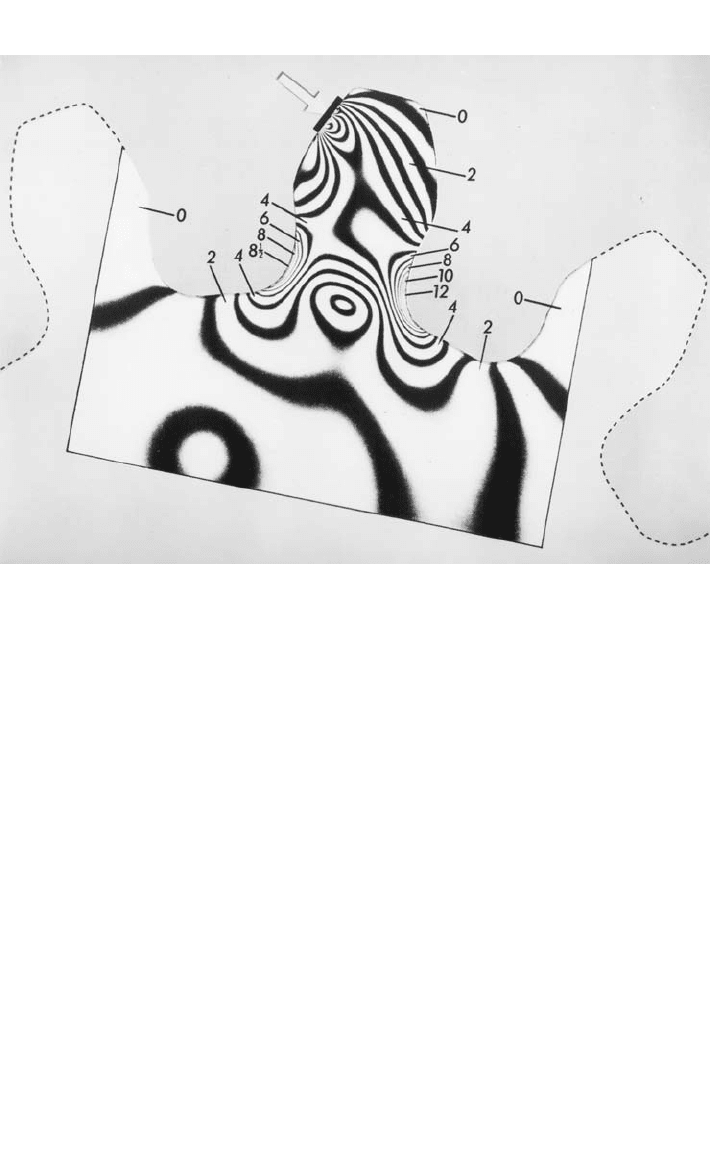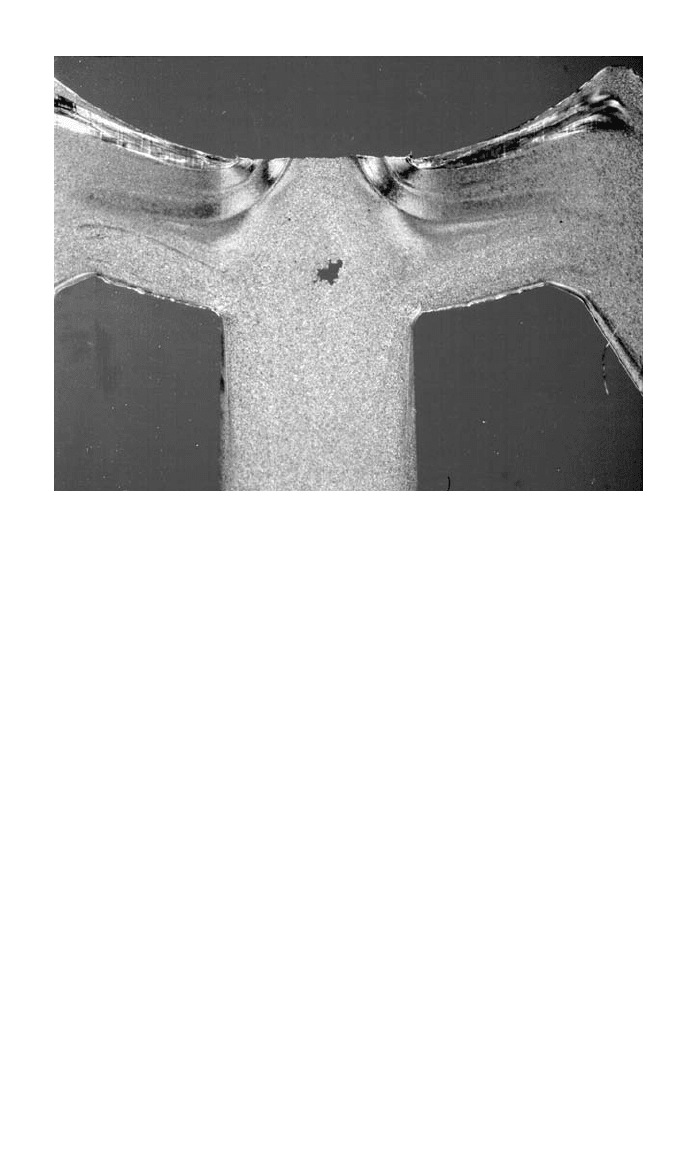Kutz M. Handbook of materials selection
Подождите немного. Документ загружается.


780 FAILURE ANALYSIS OF PLASTICS
(FT-IR) analysis and gel permeation chromatography (GPC) must be employed.
These methods can not only positively identify the basic material but also point
out the type and level of impurities in most cases.
3.3 Stress Analysis
Once the part failure resulting from poor molding practices or improper material
usage through visual examination and material identification is ruled out, the
next logical step is to carry out an experimental stress analysis. Experimental
stress analysis is one of the most versatile methods for analyzing parts for pos-
sible failure. The part can be externally stressed or can have residual or molded-
in stresses. External stresses or molded-in stresses or a combination of both can
cause a part to fail prematurely. Stress analysis is an important part of failure
identification. Detection of residual stresses has a different meaning than eval-
uation of stresses due to applied forces. It is possible of course to see failure
due to poor design or underestimating of forces. These failures are usually de-
tected in proof testing or in early production. Residual stresses are altogether
different: A molding process can generate residual stress just about anywhere,
anytime. Here, ongoing photoelastic inspection can prove extremely helpful,
allowing detection of defective molded parts or identification of failures in clear
plastic products. Experimental stress analysis can be conducted to determine the
actual levels of stress in the part. Five basic methods are used to conduct stress
analysis: photoelastic method, brittle-coating method, strain gauge method,
chemical method, and heat reversion technique.
1. Photoelastic Method. The photoelastic method for experimental stress
analysis is quite popular among design engineers and has proved to be an ex-
tremely versatile yet simple technique.
If the parts to be analyzed are made out of one of the transparent materials,
stress analysis is simple. All transparent plastics, being birefringent, lend them-
selves to photoelastic stress analysis. The transparent part is placed between two
polarizing mediums and viewed from the opposite side of the light source. The
fringe patterns are observed without applying external stress. This allows the
observer to study the molded-in or residual stresses in the part. High fringe order
indicates the area of high-stress level whereas low fringe order represents an
unstressed area. Also, close spacing of fringes represents a high-stress gradient.
A uniform color indicates uniform stress in the part. Next, the part should be
stressed by applying external force and simulating actual-use conditions. The
areas of high-stress concentration can be easily pinpointed by observing changes
in fringe patterns brought forth by external stress. Figure 1 illustrates a typical
stress pattern in a part. This type of evaluation is useful as a regular part of
product inspection for quality control of transparent parts for any manufacturer
to maintain product quality and consistency and to prevent failures. The method
often reveals problems associated with many other process control parameters
such as temperature, material, fill rate, design, etc.
Another technique known as the photoelastic coating technique can be used
to photoelastically stress-analyze opaque plastic parts. The part to be analyzed
is coated with a photoelastic coating, service loads are applied to the part, and

3 ANALYZING FAILURES 781
Fig. 1 Typical photoelastic stress pattern. (Courtesy Measurements Group, Inc.)
coating is illuminated by polarized light from the reflection polariscope. Molded-
in or residual stresses cannot be observed with this technique. However, the
same part can be fabricated using one of the transparent plastic materials. In
summary, photoelastic techniques can be used successfully for failure analysis
of a defective product.
2. Brittle-Coating Method. The brittle-coating method is yet another tech-
nique of conveniently measuring the localized stresses in a part. Brittle coatings
are specially prepared lacquers that are usually applied by spraying on the actual
part. The part is subjected to stress after air-drying the coating. The location of
maximum strain and the direction of the principal strain is indicated by the small
cracks that appear on the surface of the part as a result of external loading. Thus,
the technique offers valuable information regarding the overall picture of the
stress distribution over the surface of the part. The data obtained from the brittle-
coating method can be used to determine the exact areas for strain gauge location
and orientation, allowing precise measurement of the strain magnitude at points
of maximum interest. They are also useful for the determination of stresses at
stress concentration points that are too small or inconveniently located for in-
stallation of strain gauges. The brittle-coating technique, however, is not suitable
for detailed quantitative analysis such as photoelasticity. Sometimes it is nec-
essary to apply an undercoating prior to the brittle coating to promote adhesion
and to minimize compatibility problems.

782 FAILURE ANALYSIS OF PLASTICS
3. Strain Gauge Method. The electrical resistance strain gauge method is
the most popular and widely accepted method for strain measurements. The
strain gauge consists of a grid of strain-sensitive metal foil bonded to a plastic
backing material. When a conductor is subjected to a mechanical deformation,
its electrical resistance changes proportionally. This principle is applied in the
operation of a strain gauge. For strain measurements, the strain gauge is bonded
to the surface of a part with a special adhesive and then connected electrically
to a measuring instrument. When the test part is subjected to a load, the resulting
strain produced on the surface of the part is transmitted to the foil grid. The
strain in the grid causes a change in its length and cross section, and produces
a change in the resistivity of the grid material. This change in grid resistance,
which is proportional to the strain, is then measured with a strain gauge record-
ing instrument. In using strain gauges for failure analysis, care must be taken to
test the adhesives for compatibility with particular plastics to avoid stress-
cracking problems.
Residual or molded-in stresses can be directly measured with strain gauges
using the hole drilling method. This method involves measuring a stress at a
particular location, drilling a hole through the part to relieve the frozen-in
stresses, and then remeasuring the stress. The difference between the two mea-
surements is calculated as residual stress.
4. Chemical Method. Most plastics, when exposed to certain chemicals
while under stress, show stress cracking. This phenomenon is used in stress
analysis of molded parts. The level of molded-in or residual stress in a part
molded in ABS (acrylonitrile butadiene styrene) material can be determined by
this method. The part is immersed in a mixture of glacial acetic acid and water
for 2 min at 73
⬚F and later inspected for cracks that occur where tensile stress
at the surface is greater than the critical stress. The part may also be externally
stressed to a predetermined level and sprayed on with the chemical to determine
critical stresses. Stress cracking curves for many types of plastics have been
developed by material suppliers. If a defective product returned from the field
appears to have stress-cracked, similar tests should be carried out to determine
molded-in stresses as well as the effect of external loading by simulating end-
use conditions. Failures of such types are seen often in parts where metal inserts
are molded-in or inserted after molding. Three other tests, stain resistance test,
solvent stress-cracking resistance, and environmental stress-cracking resistance
(ESCR) are also employed to analyze failed parts. The acetone immersion test,
to determine the quality of rigid polyvinyl chloride (PVC) pipe and fittings as
indicated by their reaction to immersion in anhydrous acetone, is very useful.
An unfused PVC compound attacked by an anhydrous acetone causes the ma-
terial to swell, flake, or completely disintegrate. A properly fused PVC com-
pound is impervious to anhydrous acetone and only a minor swelling, if any, is
observed. Defective PVC pipe or fittings returned from the field are subjected
to this test for failure analysis.
3.4 Heat Reversion Technique (ASTM F1057)
All plastics manufacturing process introduce some degree of stress in the fin-
ished product. The stresses in molded parts are commonly referred to as molded-
in (residual) stresses. By reversing the process, by reheating the molded or

3 ANALYZING FAILURES 783
extruded product, the presence of stress can be determined. The test is conducted
by simply placing the entire specimen or a portion of the specimen in thermo-
statically controlled, circulating air oven and subjecting it to a predetermined
temperature for a specified time. The specimens are visually examined for a
variety of attributes. The degree and severity of warpage, blistering, wall sepa-
ration, fish-scaling, and distortion in the gate area of molded parts indicate stress
level. Stresses and molecular orientation effects in the plastic material are re-
lieved, and the plastic starts to revert to more stable form. The temperature at
which this begins to occur is important. If changes start below the heat distortion
temperature of the material, high levels of stress and flow orientation are indi-
cated. The test has been significantly improved by new methods including the
attachment of strain gauges to critical regions of the part to carefully monitor
initial changes in the shape. ASTM F1057 describes the standard practice for
estimating the quality of extruded PVC pipe by the heat reversion technique.
3.5 Microtoming
Microtoming is a technique of slicing an ultrathin section from a molded plastic
part for microscopic examination. This technique has been used by biologists
and metallurgists for years, but only in the last decade has this technique been
used successfully as a valuable failure analysis tool.
Microtoming begins with the skillful slicing of an 8- to 10-
m-thick section
from a part and mounting the slice on a transparent glass slide. The section is
then examined under a light transmission microscope equipped with a polarizer
for photoelastic analysis. A high-power (1000
⫻) microscope that will permit
photographic recording of the structure in color is preferred. By examining the
microstructure of a material, much useful information can be derived. For ex-
ample, microstructural examination of a finished part that is too brittle may show
that the melt temperature was either nonuniform or too low. The presence of
unmelted particles is usually evident in such cases. Another reason for frequent
failures of the injection-molded part is failure to apply sufficient time and pres-
sure to freeze the gates. This causes the parts to be underpacked, which creates
center-wall shrinkage voids. Figure 2 illustrates such shrinkage voids. Voids tend
to reduce the load-bearing capabilities and toughness of a part through the con-
centration of stress in a weak area.
Contamination, indicated by abnormality in the microstructure, almost always
creates some problems. Contamination caused by the mixing of different poly-
mers can be detected through such analysis by carefully studying the differences
in polymer structures. Quite often, a poor pigment dispersion also causes parts
to be brittle. This is readily observable through the microtoming technique. To
achieve optimum properties, additives such as glass fibers and fillers must dis-
perse properly. Microtoming a glass-fiber-reinforced plastic part reveals the de-
gree of bonding of the glass fiber to the resin matrix as well as the dispersion
and orientation of glass fibers. Molded-in stresses as well as stresses resulting
from external loading are readily observed under cross-polarized light because
of changes in birefringence when the molecular structure is strained. Microtom-
ing technique can also be applied to check the integrity of spin and ultrasonic
or vibration welds.

784 FAILURE ANALYSIS OF PLASTICS
Fig. 2 Shrinkage voids created by insufficient time and pressure to freeze the gates during
injection-molding process. (Courtesy BASF Corporation)
3.6 Mechanical Testing
Defective product returned from the field is often subjected to a variety of me-
chanical tests to determine the integrity of the product. Two basic methods are
employed. One method involves conducting mechanical tests such as tensile,
impact, or compression on the actual part or a small sample cut out from the
part. The test results are then compared to the test results obtained from the
retained samples. The second method requires grinding up the defective parts
and either compression or injection-molding standard test bars and conducting
mechanical tests. The test results are compared to the published data for the
virgin material. The amount of material available for molding the test bars quite
often precludes injection molding. The test data obtained from compression-
molded samples are generally lower than injection-molded samples. Fatigue fail-
ure tests such as flexural fatigue or tensile fatigue can be employed to determine
premature failure from cyclic loading.
3.7 Thermal Analysis
Thermal analysis techniques are used extensively in failure analysis. A detailed
discussion on the use of thermogravimetric analysis (TGA), thermomechanical
analysis (TMA), and differential scanning calorimetry (DSC) techniques is in a
chapter on material characterization tests.
3.8 Nondestructive Testing Techniques
NDT techniques are useful in determining the flaws, discontinuities and joints.

BIBLIOGRAPHY 785
BIBLIOGRAPHY
Durelli, A. J., Phillips, E. A., and Tsao, C. H., Introduction to the Theoretical and Experimental
Analysis of Stress and Strain, McGraw-Hill, New York, 1958.
Ezrin, M., Plastics Failure Guide Causes and Prevention, Hanser Gardner Publications, 1996, p. 154.
Holman, J. P., Experimental Methods for Engineers, McGraw-Hill, New York, 1971, pp. 333–334.
‘‘Introduction to Stress Analysis by the Photoelastic Coating Technique,’’ Tech. Bull. IDCA-I, Pho-
toelastic Division, Vishay Intertechnology, Inc.
Levys, ‘‘Product Testing, Insurance against Failure,’’ Plastics Design Forum, July–August, 83 (1984).
Measurements Group, Tech. Bull., Vishay Intertechnology, Inc.
Morita, D. R. ‘‘QC Tests That Can Help Pin Point Material or Design Problems,’’ Plastics Design
Forum, May–June, 51–55 (1980).
‘‘Reflection Polariscope,’’ Tech. Bull. S-103-A, Photoelastic Division, Vishay Intertechnology, Inc.
Sessions, M. L., Microtoming, Engineering Design with Dupont Plastics, E. I. Dupont Co., Wil-
mington, DE, Spring 1977, p. 12.
Spier, I. M., ‘‘The Most Common Mistakes Made by Design Engineer Working in Plastics,’’ Plastic
Design Forum, March / April, 24 (1986).
Tobin, W., Plastic Design Forum, Jan / Feb, 48 (1987).
Vogt, J. P., ‘‘Testing for Mechanical Integrity Assures Service Life of Plastic Parts,’’ Plast. Design
and Processing, March, 13 (1976).

787
CHAPTER 27
FAILURE MODES: PERFORMANCE
AND SERVICE REQUIREMENTS FOR
CERAMICS
Dietrich Munz
Universita¨t Karlsruhe
Institut fu¨r Zuverla¨ssigkeit und Schadenskunde im Maschinenbau
Karlsruhe, Germany
1 OVERVIEW 787
2 FLAWS 789
3 FRACTURE MECHANICS 790
4 STRENGTH 792
5 DELAYED FAILURE 792
6 SCATTER OF STRENGTH AND
LIFETIME 794
6.1 Scatter of Strength 794
6.2 Scatter of Lifetime 797
7 DESIGN APPLYING MULTIAXIAL
WEIBULL STATISTICS 798
7.1 Strength under Compression
Loading 798
7.2 Global Multiaxial Fracture
Criterion 799
7.3 Local Multiaxiality Criterion 799
8 MATERIALS SELECTION FOR
THERMAL SHOCK CONDITIONS 803
9 FAILURE AT HIGH
TEMPERATURES 805
9.1 Creep Strain 805
9.2 Creep Rupture 806
REFERENCES 808
1 OVERVIEW
A reliable design of components requires the knowledge of the possible failure
modes under service conditions and knowledge of the material properties de-
scribing these failure modes. These material properties are characterized by spe-
cific material parameters, such as strength, fracture toughness, hardness, and
relations between loading parameters and materials response, e.g., the stress–
strain curve or the S–N curve for fatigue loading. A reliable design has to
incorporate the uncertainties in the loading parameters and in the material re-
sponse. Therefore, a correct description of the scatter of the material properties
is an important part in any design procedure. Material properties usually are
determined under simple loading conditions: uniaxial loading, homogeneous
stress state, constant temperature, simple load–time variations, such as constant
load, cyclic loading, or constant loading rate. The loading conditions of com-
ponents are more complex: multiaxial and inhomogeneous stress state, complex
HandbookofMaterialsSelection.EditedbyMyerKutz
Copyright Ó 2002 John Wiley & Sons, Inc., NewYork.

788 FAILURE MODES
load, and temperature variation. Therefore, methods to transform results from
simple loading conditions to complex situations in components have to be de-
veloped and applied.
For metals, a good knowledge of failure modes, design rules following from
these failure modes, and criteria for materials selection exists. Ceramics are
brittle materials that fail without preceding plastic deformation. Only at high
temperatures may creep deformation occur before fracture. The brittle failure
mode requires specific design rules and criteria for material selection. Whereas
in metals high local stresses lead to local plastic deformation only and not to
failure of the component in ceramics, these high local stresses can lead to failure
at relatively low global stresses. High local stresses can occur under different
situations: sharp notches, thermal shock, contact loading. Tension stresses under
these conditions are dangerous because of the lower tensile strength compared
to compressive strength. From this behavior general design rules follow:
●
Avoid sharp notches.
●
Avoid surface damage, e.g., scratches.
●
Avoid sudden changes in temperature.
●
Avoid point or line loading of ceramic components.
The failure in ceramics starts from flaws introduced during fabrication or
surface treatment. These flaws may be pores, inclusions, cracks, or surface
scratches. Due to the scatter in the size of the flaws, also the strength shows a
large scatter, which is much larger than in metals. This requires special statistical
design criteria. This large scatter is associated with a large effect of the size of
the component on the strength, which has to be included in the statistical design
criteria.
Under mechanical or thermal loading, different failure modes are possible:
●
Unstable fracture
●
Subcritical extension of flaws under constant loading (static fatigue)
●
Subcritical extension of flaws under cyclic loading (cyclic fatigue)
●
Creep deformation and creep fracture at high temperatures
●
Corrosion, especially oxidation
●
Wear in components under sliding contact
The different failure modes are characterized by material properties and relations
between the applied loading in terms of stresses or stress intensity factors and
the materials response in terms of lifetime or plastic deformation. The material
properties are:
●
Tensile strength
c
or, to be more specific,
ct
●
Compressive strength
cc
●
Fracture toughness K
IC
●
Hardness H

2 FLAWS 789
Fig. 1 Flaw origin in a silicon carbide.
The failure relations are:
●
Relation between stress
and lifetime t
ƒ
●
Relation between stress amplitude
a
or stress range ⌬
⫽ 2
a
and num-
ber of cycles to failure N
ƒ
●
Relation between creep strain and time
The flaws leading to failure can be described as cracks. Therefore, the methods
of fracture mechanics can be applied to describe the flaw extension behavior.
The corresponding relations are:
●
Relation between flaw size and strength
●
Relation between crack growth rate and stress intensity factor for static
fatigue
●
Relation between crack extension for one load cycle and the range of the
stress intensity factor for cyclic fatigue
Because of the scatter in strength and in the lifetime, the failure cannot be
described by a unique strength or a fixed lifetime. For a given load, only the
probability of failure can be specified. This failure probability depends not only
on the maximum load in the component, it also depends on the size of the
component and the stress distribution in the component.
2 FLAWS
Looking on a fracture surface of a ceramic, one very often can find the origin
of the fracture. An example is shown in Fig. 1. It can distinguished between
intrinsic and extrinsic flaws. Intrinsic flaws are generated during the fabrication
process. They can be pores, shrinkage cracks, or areas of low density. Inclusions
of other materials and specific grain configurations, especially large grains may

790 FAILURE MODES
Table 1 Fracture Toughness and Strength of Different Ceramics
Fracture Toughness
(MPa )
兹m
Tensile Strength
(MPa)
Compressive Strength
(MPa)
AlN 3–4.5 300–500
Al
2
O
3
3–4.5 300–500 2500
Al
2
TiO
5
10–50
B
4
C 3.5 300–500 2900
BeO 200–400 1500
MoSi
2
300 2500
SiC hot pressed 4.6 500–850 460
Si
3
N
4
dense reaction bonded 4–8
1.5–2.8
500–1200
150–350
SiO
2
fused quartz 0.8 50–100 1300
2000
TiB
2
300–400 1600
TiC 400
ZrB
2
300
ZrO
2
8–12 800–1000 2000
Glass 0.6–1.0
lead to high microstructural residual stresses after cooling from the sintering
temperature. These stresses may cause cracks during the application of a small
mechanical load. Phase transformation during cooling or under an applied load,
accompanied by a change in volume, e.g., in zirconia, is another cause of crack
nucleation. All these flaws are primarily volume flaws that, however, may extend
to the surface. Extrinsic flaws are surface flaws caused by surface treatment,
such as machining or grinding. Oxidation at high temperature may introduce
surface pits.
3 FRACTURE MECHANICS
The flaws that cause failure are described as cracks. Consequently, the methods
of linear elastic fracture mechanics can be applied. The relation between the
size of the flaw a and the strength
c
is
K
IC
⫽ (1)
c
兹aY
where K
IC
is the fracture toughness and Y a constant that depends on the shape
of the crack. For a semicircular surface flaw there is Y
⫽ 1.28.
The fracture toughness is a material property. In Table 1 typical values of
fracture toughness are listed. They range from less than 1 MPa for glass to
兹m
8 MPa for silicon nitride and 12 MPa for zirconia. For a given material
兹m 兹m
the fracture toughness depends on the specific microstructure and density. There-
fore, a large variation of K
IC
is observed.
In Fig. 2 the strength
c
according to Eq. 1 is plotted versus the crack size a
for different values of K
IC
. A flaw of a size of 100
m leads to a strength of
391 MPa for a material with K
IC
⫽ 5 MPa (e.g., alumina) and to a strength兹m
